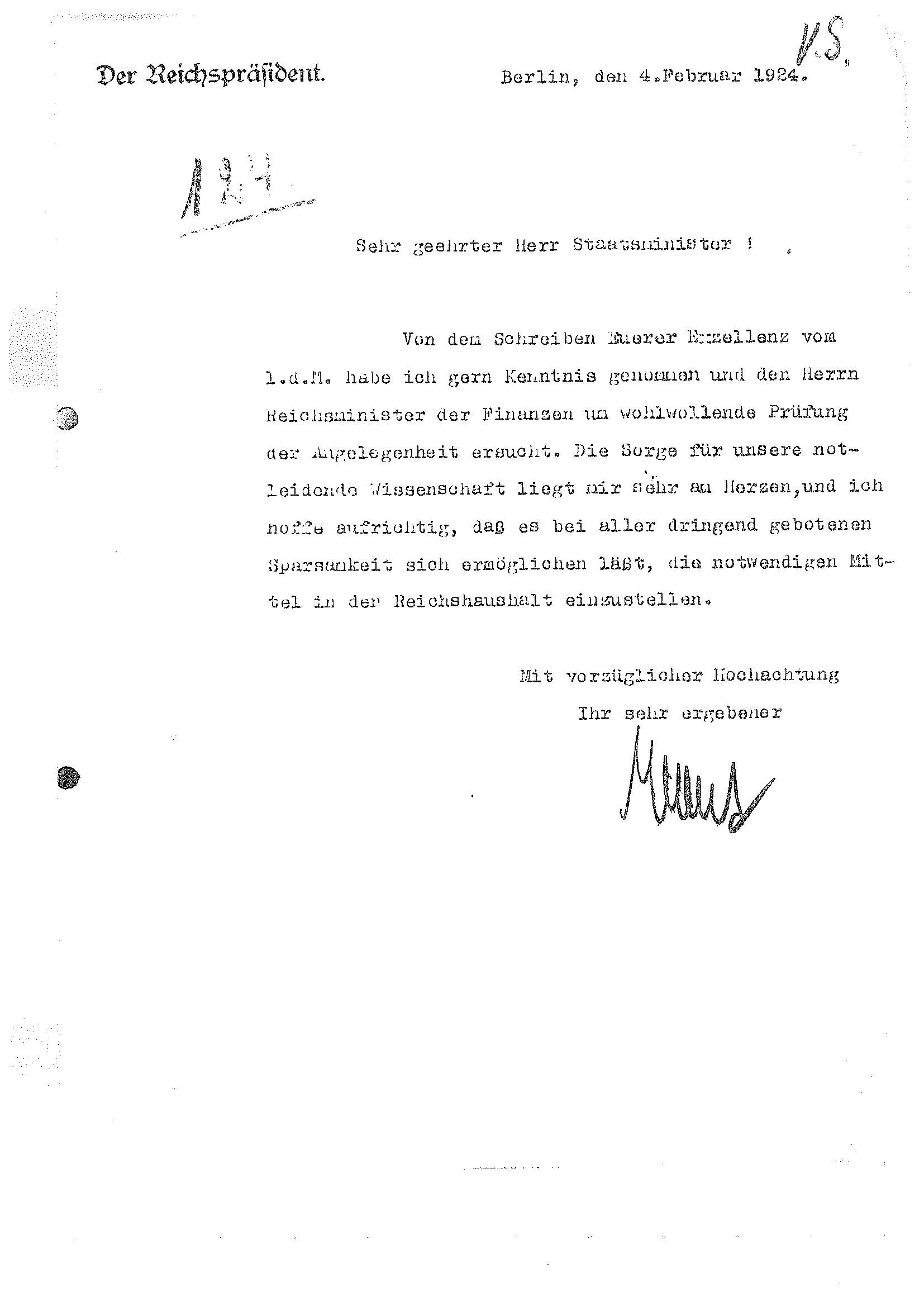From “crisis management” in research policy to priority setting
- The crisis of 1924: The Notgemeinschaft is on the brink of disbandmen(externer Link)
- A “constructive plan” instead of “emergency” – the origins of the “Community Projects(externer Link)
- Community Projects “in the area of the national economy, public health and public well-being.(externer Link)
- Further informatio(externer Link)
The crisis of 1924: The Notgemeinschaft is on the brink of disbandment

Letter from Reich President Friedrich Ebert to Friedrich Schmidt-Ott, 1924
© Aus
In the years of inflation, the Notgemeinschaft was only able to practise “crisis management in research policy"; there was no question of strategic, forward-thinking research funding.
The uncertain situation of the Notgemeinschaft continued even after the currency reform; at the end of 1923, the government of the Reich found itself facing a currency shortage. It responded with savings measures from which even the research system was not safe, hence a drastic reduction was also planned in the budget of the Notgemeinschaft. It was Friedrich Schmidt-Ott, more than anyone, who, through intense lobbying – including persistent correspondence to members of the government and Reich President Friedrich Ebert – managed to avert a budget cut and to secure an “emergency budget” of three billion Reichsmarks.
A “constructive plan” instead of “emergency” – the origins of the “Community Projects"
The battle for the budget made the Notgemeinschaft very much aware that its position within the research landscape was by no means secure. Friedrich Schmidt-Ott began to look around for options in order to demonstrate the importance of the Notgemeinschaft and raise its profile.
Leading government representatives had already made clear in debate surrounding the budget cuts that further research funding from the Reich would mainly benefit product-related science and technology research. The impetus to set priorities in research funding also came from industry, which complained of an acute shortage in qualified early career research staff. The Notgemeinschaft responded to this, establishing special committees financed by industry donations that awarded research fellowships in the fields of medicine and electrical engineering.
Friedrich Schmidt-Ott received encouragement at the international level, also, to set a particular course in research policy, over and above merely reacting to proposals. In January 1925 he presented plans for the “organisation of research projects” in a meeting of the Joint Committee. The inspiration for this idea was the American National Research Council, which coordinated research projects of economic significance in committees. The Director of the European Office of the Rockefeller Foundation, Henry Eversole, also advised Friedrich Schmidt-Ott to develop a “constructive plan” rather than remaining in a state of “emergency”.
Community Projects “in the area of the national economy, public health and public well-being.”
After consultations with members of the Notgemeinschaft – primarily with the President of the Kaiser Wilhelm Society, Adolf von Harnack – and gauging the general mood in political circles, it was clear to Friedrich Schmidt-Ott that it was only through major research projects, which must however address “a national need” and be backed by experts both from research and industry, that the Notgemeinschaft could obtain “a proper backbone” for its work.
In an initial phase, the Notgemeinschaft therefore focused its research on the areas of metal research, geophysics, medical and nutrition sciences, on which researchers at various locations and in a variety of fields worked in a research group. In May 1925, the organisation successfully lobbied the Reichstag for additional funding by means of the “Denkschrift über die Forschungsaufgaben der Notgemeinschaft der Deutschen Wissenschaft im Bereich der nationalen Wirtschaft, der Volksgesundheit und des Volkswohls” (Memorandum on the research tasks of the Notgemeinschaft der Deutschen Wissenschaft in the area of the national economy, public health and public well-being). Special funding was allocated to the Notgemeinschaft for the year, increasing the annual budget for 1926 by 30 percent. The number of fellowship recipients increased from 93 in 1924 to 344 in 1926.
Not all “Community Projects” were interdisciplinary group research projects; in many cases, individual research tasks were simply grouped under a general title. Nevertheless, the Notgemeinschaft achieved an autonomous profile by positioning itself as a force that shaped research funding.
However, it was not just industry, but also the military that were interested in "Community" research projects. The nationalistic objectives of the military ultimately also boiled down to questions concerning a self-sufficient economy and armaments. Since 1927, the Reichswehr had been attempting to second specialist representatives of the army to Notgemeinschaft committees, and the leadership of the Notgemeinschaft did not oppose these efforts. Hence the Notgemeinschaft was already involved in secret research projects of the Reichswehr prior to 1933.
Further information
Access to the historical records
“GEPRIS Historisch” is the comprehensive information portal provided by the DFG that makes the history of the DFG and of research between 1920 and 1945 publicly accessible:
Information on literature used and sources